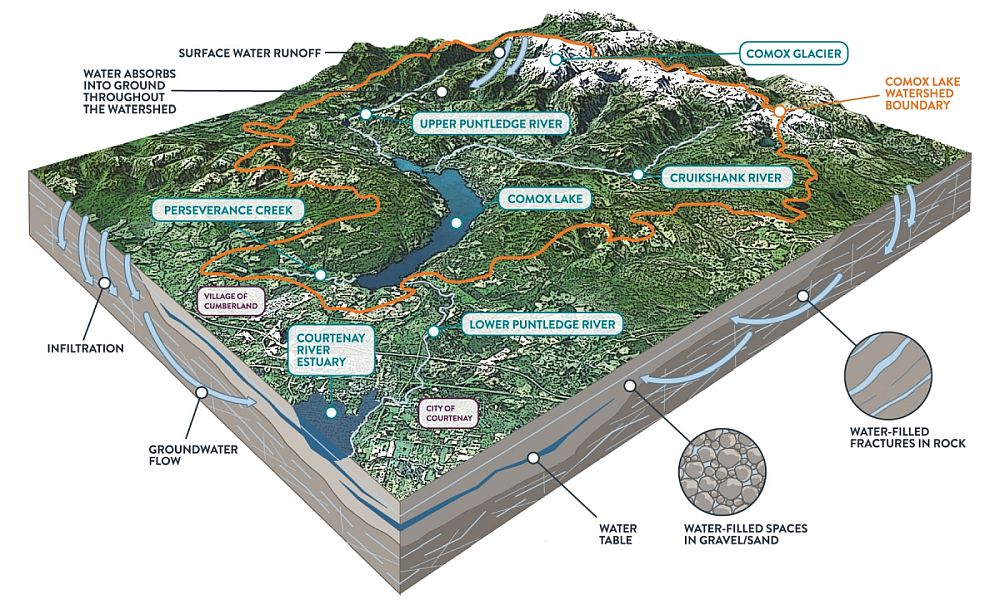COMOX LAKE WATERSHED PROTECTION PLAN: At the Parksville 2019 Symposium, Marc Rutten will elaborate on why Comox Valley local governments and K’ómoks First Nation are embarking on an initiative to strengthen the role of nature in protecting drinking water supplies (Module B on Day Two – panel vignette on “Improving Where We Live”)
Note to Reader:
At the Parksville 2019 Symposium in April, Marc Rutten is a member of a 5-person panel team that will prime the audience for a town-hall ‘sharing & learning session by presenting 5-minute vignettes on long-term and emerging initiatives in regional districts on the east coast of Vancouver Island. Inspirational in scope, these demonstrate what is achievable when there is a restoration imperative.
Marc Rutten will talk about the Comox Lake Watershed Protection Plan. His presentation is timely because the four Comox Valley local governments have embarked on a journey to better measure and manage natural assets (e.g. forests, riparian areas) into core asset management and financial processes.

Comox Lake Watershed Protection Plan:
Collaborative Process = Community Support
The Comox Lake watershed (refer to image below) is the drinking water source for over 45,000 people in the City of Courtenay, the Town of Comox, and the Comox Valley Regional District (CVRD) electoral areas, as well as over 3,700 people in the Village of Cumberland.
In 2018, the K’ómoks First Nation (KFN) signed a Mutual Benefit Agreement confirming cooperation and collaboration in the management of water resources in the region. The agreement includes plans to extend water services to KFN lands and greater participation by KFN in the management of regional water resources.
The area of land that drains into Comox Lake is approximately 461 square kilometres and the majority is K’ómoks First Nation traditional territories. A major challenge in the Comox Lake watershed is that it is a multi-use watershed with multiple owners. Along the shoreline, there are nine different categories of landowners or responsible jurisdictions.
The lands and waterways in the watershed are popular recreational destinations for swimming, boating, fishing and hiking, along with active logging throughout much of the watershed. The waterways of the Comox Lake watershed also provide critical fish and wildlife habitat and hydroelectric power generation.
About the Plan
 “The Comox Lake Watershed Protection Plan was developed by the Watershed Advisory Group (WAG), a comprehensive group of stakeholders representing a broad variety of interests. Along the way, the process fostered relationships and built trust among the many stakeholders, including all four local governments. The Watershed Protection Plan is truly a collaborative outcome. But a plan is nothing without follow-through and implementation. We’ve got the support. This plan will not sit on a shelf,” states Marc Rutten, General Manager of Engineering, Comox Valley Regional District.
“The Comox Lake Watershed Protection Plan was developed by the Watershed Advisory Group (WAG), a comprehensive group of stakeholders representing a broad variety of interests. Along the way, the process fostered relationships and built trust among the many stakeholders, including all four local governments. The Watershed Protection Plan is truly a collaborative outcome. But a plan is nothing without follow-through and implementation. We’ve got the support. This plan will not sit on a shelf,” states Marc Rutten, General Manager of Engineering, Comox Valley Regional District.
“Providing drinking water to our communities requires two important steps: treating the water and protecting the source. Balancing interests such as private ownership, active logging, recreation and hydroelectric power generation, while sustaining critical fish and wildlife habitat, provides challenges for watershed management.”
To Learn More:
Download Peer-based Learning is Motivating and Powerful – Moving Towards “Sustainable Watershed Systems, through Asset Management”, released in May 2017.
And, to learn about the Panel planned for Parksville 2019, read MODULE B – DAY TWO – PARKSVILLE 2019 SYMPOSIUM: A Panel & Town-Hall Session on “Improving Where We Live” features five Vancouver Island initiatives to demonstrate what is possible through a Whole-System Approach

Recognition of Nature’s Role in Drinking Water Infrastructure
In March 2019, it was announced that local governments and the K’òmoks First Nation in the Comox Valley have joined forces to launch a $367,500, multi-year initiative with the Municipal Natural Assets Initiative to help better measure and manage critical drinking water infrastructure provided by nature.
The Project Partners – Comox Valley Regional District, City of Courtenay, Town of Comox, Village of Cumberland and the K’òmoks First Nation – have signed a memorandum of understanding with the Municipal Natural Assets Initiative to value natural assets in the Comox Lake watershed that provide safe, reliable drinking water, as well as to develop and implement strategies for their effective management.
Local governments depend on infrastructure like roads, pipes, sewers, libraries and buses. This project is based on the idea that nature also is crucial to the livability of our communities and to the provision of core services. For example, forested watersheds provide people with clean drinking water, wetlands protect communities from floods and vegetated banks protect our home properties from erosion – as well as may other benefits.
To Learn More:
For the complete story, download a copy of the Report to Comox Valley Regional Board, February 2019.
Quotable Quote – Comox Valley Regional District:
 “Canadian local governments recognize increasingly that healthy natural assets provide many services to local governments as engineered assets, at lower lifecycle cost. I am delighted to work together with regional partners to develop cost-effective, nature-based strategies to deliver clean, healthy drinking water,” said Russel Dyson, Chief Administrative Officer of the Comox Valley Regional District. “This project will help our communities benefit from affordable, long-term and reliable sources of clean drinking water” he added.
“Canadian local governments recognize increasingly that healthy natural assets provide many services to local governments as engineered assets, at lower lifecycle cost. I am delighted to work together with regional partners to develop cost-effective, nature-based strategies to deliver clean, healthy drinking water,” said Russel Dyson, Chief Administrative Officer of the Comox Valley Regional District. “This project will help our communities benefit from affordable, long-term and reliable sources of clean drinking water” he added.
Quotable Quote – City of Courtenay:
 “In 2018, the City of Courtenay partnered with the Municipal Natural Assets Initiative to determining how natural assets could help us manage flood risks. We’re delighted that this original project has provided impetus for a regional initiative focused on drinking water,” said David Allen, Chief Administrative Officer of the City of Courtenay.
“In 2018, the City of Courtenay partnered with the Municipal Natural Assets Initiative to determining how natural assets could help us manage flood risks. We’re delighted that this original project has provided impetus for a regional initiative focused on drinking water,” said David Allen, Chief Administrative Officer of the City of Courtenay.
Quotable Quote – Municipal Natural Assets Initiative
 “We look forward to working with all partners in the community to better understand in very specific terms the role of the watershed in terms of providing clean drinking water. Once we understand the cost of replacing natural services with engineered assets, municipalities can develop strategies manage them as deliberately and effectively as any valuable engineered asset, to ensure its long-term health,” said Michelle Molnar, Technical Director for the Municipal Natural Assets Initiative.
“We look forward to working with all partners in the community to better understand in very specific terms the role of the watershed in terms of providing clean drinking water. Once we understand the cost of replacing natural services with engineered assets, municipalities can develop strategies manage them as deliberately and effectively as any valuable engineered asset, to ensure its long-term health,” said Michelle Molnar, Technical Director for the Municipal Natural Assets Initiative.

